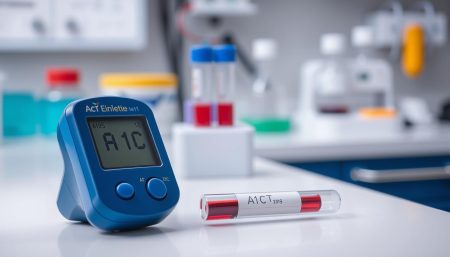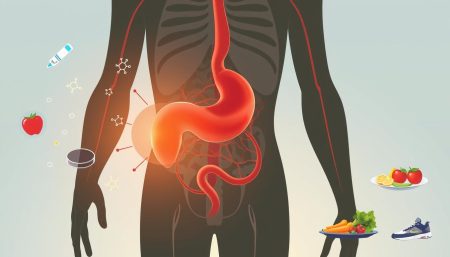Pre diabetes mellitus is a warning sign for a major health issue. It means blood sugar levels are too high but not yet diabetes. Knowing how to stop it early is key to staying healthy and keeping blood sugar in check.
Stopping diabetes before it starts is a big challenge. We need to understand what causes pre diabetes and how to prevent it. By learning how to act early, we can fight diabetes more effectively. This guide is for anyone ready to protect their health from diabetes.
Start this important journey to learn about pre diabetes mellitus. We’ll explore ways to prevent diabetes and keep blood sugar levels healthy. Together, we can work towards a healthier future.
Understanding Pre Diabetes Mellitus
Pre diabetes mellitus is a serious health condition that can lead to type 2 diabetes. It happens when blood sugar levels are higher than normal but not high enough to be called diabetes. This stage is seen as a chance to stop diabetes from happening by changing your lifestyle and keeping an eye on your health.
Defining Pre Diabetes Mellitus
Pre diabetes is when the body can’t handle glucose well, causing slightly high glucose levels. If not handled right, it can turn into type 2 diabetes. People with pre diabetes often don’t show clear prediabetes symptoms. So, getting checked regularly is key.
The Importance of Early Detection
Finding pre diabetes early is very important. It lets people make the right lifestyle changes. These changes can help reverse insulin resistance and lower the chance of getting diabetes.
Statistics on Pre-Diabetic Conditions
The number of people with pre diabetes is very high, with millions at risk of diabetes. The table below shows recent numbers:
| Year | Pre-Diabetic Population (millions) |
|---|---|
| 2018 | 84.1 |
| 2019 | 88.4 |
| 2020 | 92.0 |
| 2021 | 96.7 |
Exploring the Causes of Pre Diabetes
Understanding pre diabetes is key to preventing it. This section looks at how genetics, lifestyle, and hormones play a part. It helps us understand risk factors for diabetes and insulin resistance better.
Genetic Predisposition and Heredity
Genetics greatly affect our risk of getting pre diabetes. Family history can increase this risk. It shows how genes can set up a person for insulin resistance.
The Impact of Lifestyle on Blood Sugar Levels
Our diet, exercise, and lifestyle choices affect blood sugar. Eating too many calories, not exercising enough, and gaining weight can raise risk factors for diabetes.
Hormonal Influences and Prediabetes
Hormonal issues, like PCOS, can affect insulin sensitivity. This can lead to pre diabetes. These conditions can disrupt insulin function and lead to insulin resistance.
Recognizing Prediabetes Symptoms
It’s important to know the prediabetes symptoms early on. Prediabetes often doesn’t show clear signs, so regular health checks are key. When symptoms do show up, they usually relate to blood sugar levels.
Common signs include feeling very thirsty, needing to pee a lot, and feeling tired for no reason. These happen because the body can’t handle sugar well. Spotting these signs means it’s time for a doctor’s visit and to check blood sugar.
- Increased thirst: Too much sugar in the blood makes you feel dehydrated and thirsty all the time.
- Frequent urination: The body tries to get rid of sugar by peeing more, often at night.
- Unexplained fatigue: Without enough sugar, cells don’t get the energy they need, making you feel tired all the time.
Knowing these signs helps people at risk get medical help fast. It’s also important to keep an eye on blood sugar levels regularly. Even if you feel fine, getting tested can catch high glucose levels early.
The Role of Insulin Resistance in Pre Diabetes Mellitus
Insulin resistance plays a big role in pre diabetes mellitus, leading to high blood sugar levels. It happens when cells don’t respond well to insulin. This stops glucose from getting into cells, causing sugar to build up in the blood. Knowing about insulin resistance helps us find ways to stop or reverse pre diabetes.
Many things can cause insulin resistance, like genetics, being overweight, and not moving enough. These issues make it hard for insulin to work right. The pancreas then makes more insulin, but it can get tired and lead to diabetes if not fixed.
| Factor | Impact on Insulin Resistance | Effect on Blood Sugar Levels |
|---|---|---|
| Genetics | Can predispose individuals to higher natural insulin resistance | Potentially uncontrollable increase without intervention |
| Obesity | High fatty tissue amounts interfere with insulin’s ability | Consistently elevated, harder to manage |
| Physical Inactivity | Lowers muscular insulin sensitivity | Accumulates higher glucose levels in the bloodstream |
Changing our lifestyle can help fight insulin resistance. Eating better and moving more are key. Keeping an eye on these habits is vital to stop blood sugar from rising and to manage or reverse pre diabetes.
Assessing Risk Factors for Diabetes
It’s important to know the different risk factors for diabetes. Age, genetics, body type, and ethnic background all play a part. Lifestyle choices also affect the risk, mainly by causing insulin resistance.
Age and Family History
As people get older, the chance of getting diabetes goes up. If your family has diabetes, you’re at higher risk. Knowing your family history can lead to early tests and care.
Weight and Body Composition Concerns
Being overweight, and having extra fat around the belly, can lead to insulin resistance. Belly fat is very active hormonally. This can mess with how your body handles sugar and raise your diabetes risk.
Ethnicity and Environmental Factors
Diabetes rates vary among different ethnic groups. This shows how genetics and environment work together. Groups like African Americans, Hispanic Americans, Native Americans, and Asian Americans face a higher risk. Things like access to healthy food and places to exercise are also important.
Monitoring Blood Sugar to Manage Pre Diabetes Mellitus
Managing pre diabetes mellitus well depends on tracking blood sugar levels accurately. By checking blood sugar often, people can make better choices about what they eat, how much they exercise, and their lifestyle. This helps stop diabetes from happening. We will look at how to monitor glucose and understand the results to keep blood sugar healthy.
Glucose Monitoring Techniques
There are many ways to check glucose levels, each with its own benefits. The most common is finger-prick tests, where a small blood sample is tested by a glucose meter. This method gives quick results, helping to adjust blood sugar levels right away.
Continuous Glucose Monitors (CGMs) are also popular. They show glucose levels all day without needing to prick your finger many times. These devices track glucose over time, showing trends that help improve diabetes management.
Interpreting Blood Sugar Level Results
It’s just as important to understand the numbers as it is to take them. Blood sugar levels can change for many reasons, like what you eat, how active you are, and stress. So, it’s key to look at these numbers in the context of your daily life to keep blood sugar healthy.
If you use traditional glucose meters, keep a log of your readings. See how they relate to when you eat, exercise, and other activities. CGMs come with software that makes it easier to see patterns and make changes to your habits.
Talking regularly with your healthcare provider about your results is important. It helps get personalized advice and updates to your treatment plan. Whether you use finger-prick tests or CGMs, the secret to good glucose monitoring is consistent practice and careful analysis of your data.
Lifestyle Changes for Preventing Diabetes
Making big lifestyle changes is key to preventing diabetes. This part talks about important changes that stop prediabetes from turning into diabetes. These changes also make your life healthier overall.
- Dietary Adjustments: Eating a balanced diet with lots of fiber, whole grains, and lean proteins helps a lot. Try to eat less sugar and fat.
- Increased Physical Activity: Doing activities like brisk walking, cycling, or swimming for 150 minutes a week boosts insulin sensitivity. It also helps manage your weight.
- Smoking Cessation: Quitting smoking lowers your diabetes risk and improves your heart health.
- Stress Management: Doing yoga, meditation, or social activities can lower blood sugar levels. It helps in preventing diabetes.
Starting these lifestyle changes needs dedication and regular effort. But the benefits are huge. Here are some practical steps:
- Plan your meals and snacks to include lots of nutrients.
- Start with easy exercises and set achievable goals.
- Get help to quit smoking, like counseling or nicotine replacement.
- Use apps or classes to help with mindfulness practices.
| Change | Benefits | Implementation Tips |
|---|---|---|
| Nutritional Adjustments | Lower risk of type 2 diabetes, Improved heart health | Introduce more fruits, vegetables, and whole grains |
| Regular Exercise | Increased insulin sensitivity, Weight management | Join a gym, find a workout buddy |
| Quit Smoking | Reduced overall health risks, Enhanced lung capacity | Access cessation programs, Avoid triggers |
| Stress Management | Lower blood sugar levels, Enhanced mental health | Adopt relaxation techniques like meditation or Tai Chi |
Nutrition and Prediabetes Diet
Managing prediabetes starts with the right diet. A balanced diet can help prevent type 2 diabetes. This section looks at how food choices can keep blood sugar stable and improve health.
Choosing the Right Foods
It’s key to pick foods low in added sugars and fats. Foods like legumes, whole grains, and veggies help control blood sugar. They release glucose slowly, keeping blood sugar stable.
Dietary Patterns to Reduce Risk
Following the Mediterranean or DASH diet can help with prediabetes. These diets focus on fruits, veggies, whole grains, and healthy fats. They’re great for lowering insulin resistance and keeping a healthy weight.
Understanding Carbohydrates and Glycemic Index
The glycemic index (GI) shows how carbs affect blood sugar. Choosing low-GI foods is important for a prediabetes diet. They help sugars release slowly, avoiding blood sugar spikes.
| Food Category | Examples | Glycemic Index Range |
|---|---|---|
| Low-GI Foods | Apples, lentils, oatmeal | Under 55 |
| Medium-GI Foods | Brown rice, whole wheat bread | 56 – 69 |
| High-GI Foods | White bread, pretzels | 70 and above |
The Impact of Physical Activity on Pre Diabetes Mellitus
Regular physical activity is key in preventing diabetes. For those at risk of pre diabetes mellitus, exercise boosts insulin sensitivity. It helps manage blood sugar levels well. This section shows how to add exercise to your daily life, no matter your fitness level.
Exercise controls weight and improves insulin use. From brisk walking to strength training, these activities help blood glucose. Choose activities that fit your lifestyle and health to stay consistent and avoid injuries.
- Brisk Walking: Easy for most people.
- Swimming: Good for those with joint issues.
- Cycling: Builds strength without overdoing it.
- Strength Training: Increases muscle, helping glucose absorption.
- Yoga: Improves flexibility, reduces stress, and boosts glucose metabolism.
Adding these activities to your routine helps prevent diabetes and boosts health. Aim for at least 150 minutes of moderate activity weekly. This can lead to noticeable health improvements related to pre diabetes mellitus.
| Activity | Benefits | Suggested Duration/Week |
|---|---|---|
| Brisk Walking | Improves heart health and insulin sensitivity. | 150 minutes |
| Strength Training | Boosts muscle mass, improving glucose uptake. | 90 minutes |
| Cycling | Increases stamina and cardiovascular fitness. | 120 minutes |
| Yoga | Improves metabolism and reduces stress levels. | 150 minutes |
By becoming more active, you can stop pre diabetes from getting worse. You also improve your overall health and well-being. Adding regular exercise to your life is a key part of making lasting lifestyle changes to prevent diabetes.
The Importance of Weight Management in Pre Diabetes Mellitus
Managing your weight is key in fighting pre diabetes mellitus. It helps lower insulin resistance. Keeping a healthy weight also keeps blood sugar levels in check and supports your body’s functions.
Strategies for Healthy Weight Loss
- Eat a balanced diet full of fiber, whole grains, and lean proteins. This helps you feel full and get the nutrients you need.
- Make exercise a part of your daily life. Try walking, cycling, or swimming to increase your metabolism and burn calories.
- Get help from healthcare experts to make a weight loss plan that fits your health and goals.
Maintaining Weight Loss for Health Benefits
Keeping the weight off is important for your health, and it lowers the risk of type 2 diabetes. Staying on track with weight management helps control insulin resistance and keeps blood sugar stable.
- Keep an eye on your weight and body composition. Adjust your diet and exercise as needed.
- Try stress-reducing activities like yoga and meditation to avoid overeating.
- Surround yourself with people who support healthy living and weight management.
Consistent weight management and lowering insulin resistance are game-changers for pre diabetes mellitus health. By following these tips, you can greatly improve your life and lower the risk of serious health problems.
Medication and Medical Interventions for High-Risk Individuals
Dealing with pre-diabetes is a big challenge. Finding the right time and way for medical interventions is key, mainly for those at high risk. These steps can help stop diabetes and manage early problems.
When to Consider Medication
Medicine is often needed when diet and exercise alone can’t control blood sugar. This is true for those with many risk factors for diabetes. Doctors might prescribe drugs to keep blood sugar stable and prevent type 2 diabetes.
Preventative Medical Therapies
Preventative medical therapies offer many options to stop diabetes from getting worse. Metformin is a common drug for those with insulin resistance to control blood sugar.
New treatments, like injectables, are also being used. They help improve insulin sensitivity and delay diabetes symptoms in at-risk groups. This early action is key to avoiding diabetes’s long-term health issues.
Diabetes is a complex disease. It’s important for people to talk to doctors for personalized advice and treatment. This ensures each patient gets the best care for their specific needs and risks. It makes prevention efforts more effective.
Psychological Aspects of Coping with Prediabetes
Getting a prediabetes diagnosis can stir up a lot of feelings. You might feel shocked, scared, or unsure. It’s important to tackle these emotions to manage your symptoms and make lifestyle changes.

First, it’s key to understand how prediabetes affects you emotionally. Many people feel stressed about changing their lifestyle or worried about getting type 2 diabetes. These feelings can really affect your mental health.
- Acceptance: Coming to terms with prediabetes as a part of your life but not the entirety of it.
- Education: Understanding prediabetes symptoms and their implications can demystify the condition and reduce fear.
- Support: Leaning on family, friends, or finding a community with similar experiences can provide emotional sustenance and practical advice.
- Professional help: Consulting with counselors or therapists who specialize in chronic illness can offer strategies to cope with stress and anxiety.
It’s also important to make lifestyle changes gradually. Start with small goals like being more active or eating better. These small wins can boost your confidence and control over your health.
Managing your mental health and making lifestyle changes are key to dealing with prediabetes. By focusing on both, you can lead a healthier life and possibly avoid type 2 diabetes.
Remember, you’re not alone in this journey—seeking help and creating a support network can make a significant positive impact on your psychological and physical health.
Getting Support: The Role of Community and Networks
When it comes to preventing diabetes, community support is key. People with pre diabetes mellitus find it easier to live healthier with the help of supportive peers. They get emotional support, advice, and encouragement from their community.
Local health groups and online forums are great places to find help. They offer a space for people to share their experiences and tips. This support helps in managing blood sugar and making lifestyle changes, which are important in preventing diabetes.
Looking at success stories, like overcoming Addison’s disease, shows the power of community support. It proves that with dedication and support, managing chronic conditions is possible.
Family support is also vital in managing pre diabetes mellitus. When family members are involved, making healthy changes is easier. Working together towards a healthy lifestyle helps prevent diabetes and improves overall health.
FAQ
Q: What exactly is pre diabetes mellitus and why is it important to pay attention to it?
A: Pre diabetes mellitus means your blood sugar is higher than normal but not high enough to be called diabetes. It’s important because it raises your risk of getting type 2 diabetes, heart disease, and stroke. Catching it early can help prevent these serious health issues.
Q: How can pre diabetes mellitus be detected early?
A: You can catch it early by getting your blood sugar checked regularly. This is more important if you have a family history of diabetes or signs of insulin resistance. Paying attention to symptoms like thirst, frequent urination, and feeling tired can also lead to early testing and treatment.
Q: Are there specific causes or risk factors that contribute to the development of pre diabetes mellitus?
A: Yes, there are many. Risk factors include your genes, a poor diet, not being active enough, hormonal issues like polycystic ovary syndrome, your weight and body shape, age, ethnicity, and environmental factors.
Q: Can changes in diet and lifestyle really help prevent the progression of pre diabetes to diabetes?
A: Absolutely. Making healthy changes like eating better, being more active, losing weight, quitting smoking, and managing stress can greatly lower your risk of getting diabetes from pre diabetes.
Q: What role does insulin resistance play in pre diabetes mellitus?
A: Insulin resistance is a big part of pre diabetes mellitus. It happens when your body’s cells don’t use insulin well, causing your blood sugar to rise. If not managed, it can lead to pre diabetes and then type 2 diabetes.
Q: What techniques are available for monitoring blood sugar levels at home?
A: There are a few ways to check your blood sugar at home. You can use finger-prick glucose meters or continuous glucose monitors (CGMs). Both help you track your blood sugar and manage your condition.
Q: How can nutrition impact insulin resistance and blood sugar levels?
A: Eating a diet rich in whole, nutrient-dense foods can help control your blood sugar and improve insulin resistance. Foods with a low glycemic index and balanced, portion-controlled meals are key in managing prediabetes.
Q: What type of physical activity is recommended for someone with pre diabetes mellitus?
A: Aim for at least 150 minutes of moderate-intensity aerobic activity each week, like brisk walking, swimming, or cycling. Also, do muscle-strengthening activities on two or more days a week. Even a little more activity can help a lot.
Q: Is medication necessary for managing pre diabetes mellitus?
A: Sometimes, medication is needed for people at high risk of getting type 2 diabetes, even if they’ve made lifestyle changes. Medicines like Metformin can help control blood sugar, mainly for those with obesity or a strong family history of diabetes.
Q: How can someone with pre diabetes get support to make necessary lifestyle changes?
A: You can find support through healthcare providers, diabetes education programs, support groups, online forums, and community resources. These can offer education, motivation, and accountability to help manage prediabetes effectively.


















